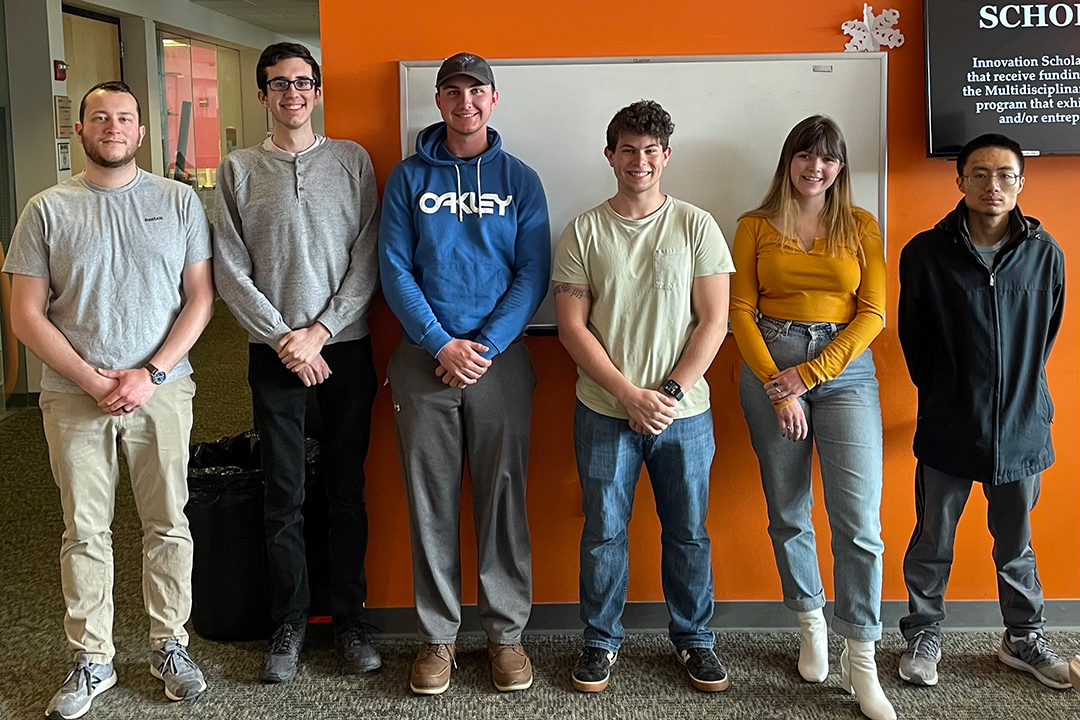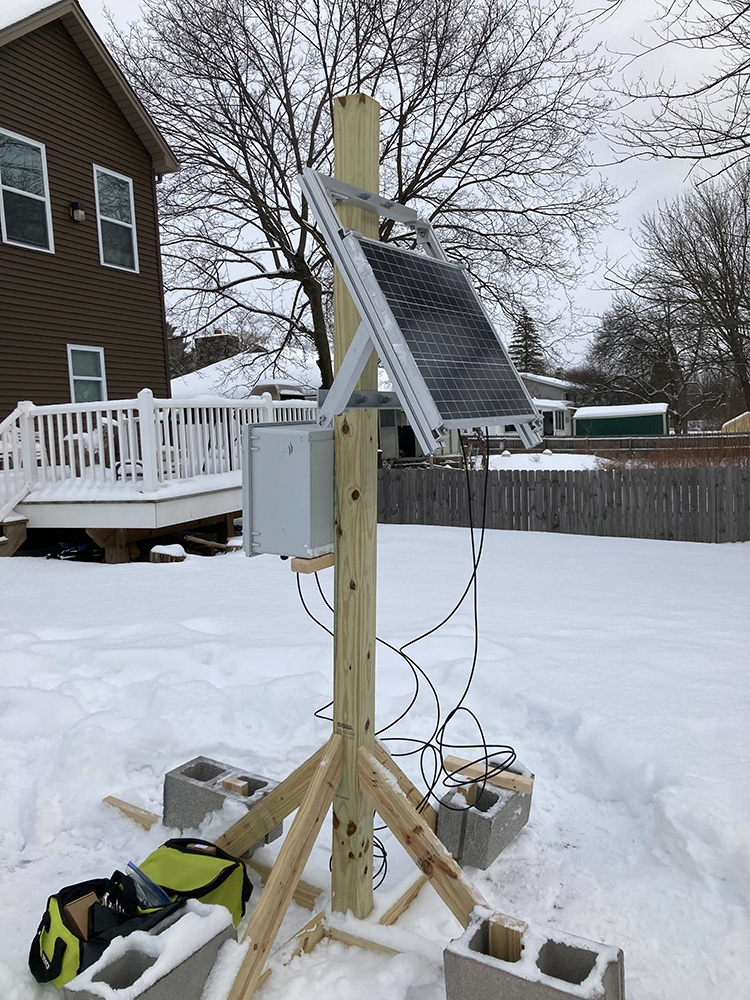Student engineers work with the city of Rochester to improve snow removal
Prototype sensor suite powered by solar technology to assess high-traffic areas needing additional plow coverage
City of Rochester snow removal processes could be enhanced with a prototype sensor suite powered by solar technology developed by RIT engineering students with members of the city’s service team.
Data can help solve weather-related transportation problems, at least that is the basis of work being done by Rochester Institute of Technology students and the city of Rochester to improve its snow removal operations.
Working with the city’s departments of Data Analytics and Environmental Services’ staff, undergraduate engineering students built a prototype solar monitoring system. It will provide needed information about snow build up on the city’s busiest streets and provide real-time data to staff to open high-traffic areas safely and efficiently.
Team members Matt Alderfer, left, Jonathan Leduc, Trevor Povlock, Ty Freeman, Sophie Buckwalter, and Alexander Guan.
At the end of this semester, they will have built a high-tech sensor unit to be installed on a city of Rochester utility pole. System data feeds will connect to the city and provide a season of information about snow fall. Data collected from the system will also be included in the city’s efforts to successfully compete for federal infrastructure funding.
“It is hard to get government to invest in this type of speculative technology without seeing how it works,” said Kate May, director of the Data Analytics and Performance Department. “Having this sort of prototype in use will hopefully give us some advantage in applying for funding. We can say we tested it and we know it is a viable concept. We can evaluate this against the market. So, it gives us information.”
That information gathering began in September.
The engineering Multidisciplinary Senior Design Program has two parts— research and design in fall and build and testing in spring. Teams consist of students from the different engineering disciplines in RIT’s Kate Gleason College of Engineering to create value for their clients by developing all elements of a new product or process.
Early design requirements and detailed drawings for the city’s system included cellular connectivity, high-tech sensors, and battery technology that can withstand low temperatures.
“Initially our project was to have a snow sensor that would plug into light poles. After the first or second meeting, they decided they wanted it to be solar powered so that it could power itself, which threw us for a loop because solar panels in snow are not always the most optimal situation. That required a lot more research,” said Sophie Buckwalter, a fourth-year electrical engineering student from Mt. Joy, Pa., and team member.
Undergraduate engineering students built a prototype solar monitoring system.
Some of that research included scouting locations of electrical poles, understanding dimensions, and researching different types of batteries to power the electronics. They asked questions about effectiveness of solar panels in a city that is not always known for its sunny days in winter. (Rochester gets, on average, 165 sunny days per year.)
A battery system would be the central powering unit for the sensors, but different chemicals in batteries respond to cold weather differently.
“We had to do research into what would be the best chemical make up for our battery, what is the best size, because this thing will be strapped to a pole,” said Ty Freeman, a fourth-year electrical engineering student from Puyallup, Wash. “We also had to think about weight requirements and with the solar panel, if we make it too big, it could act as a sail.”
Snow removal in Rochester involves plowing and de-icing areas across the 37 square miles of the city. It entails human inspectors, data from the National Weather Service, and citizen reports through 311/emergency calls. A supplement to this system could be a cost savings and preventive measure. Rochester averages nearly 100 inches of snow each year, substantially more than even a familiar snow city like Denver, where May had worked prior to coming to Rochester. She is responsible for implementing technical solutions that harness data to evaluate and continually improve services.
“I can see this system being used in areas where there are important bus routes, things where there is extra importance, and knowing that the road conditions at that location might be strategic. That is the vision, not just saving money,” said May. “Decisions are not just based on intuition and experiences; it is also based on data and strategy.”
Understanding experience and strategy is another feature of the senior design program objectives. Working with a faculty guide and the project sponsor, students learn about technical processes, user-centered design, and how to react to issues that arise.
“They are learning how to build a product that can be put into an environment in a city, and they are learning about more of the considerations beyond just as an engineer—who may not be directly interacting with the public or seeing that the build environment is a living, breathing thing,” May added. “As a former student, I know the blackboard has a lot of certainties. And in the real world, things are never as clean or simple. There are always extra variables, and if you get frustrated with that, transitioning from academia to the real world, that is not going to work well. Luckily RIT engineers are pretty good at that.”
Students on the city of Rochester project team include Buckwalter and Freeman, in addition to Matt Alderfer, mechanical engineering, from Sellersville, Pa.; Trevor Povlock, mechanical engineering, from Fairport, N.Y.; Alexander Guan, computer engineering, from Chattanooga, Tenn.; and Jonathan Leduc, industrial engineering, from Mendon, Mass. Several team members expect to gradate this May. Their faculty advisor and team guide is Mark Minunni.









